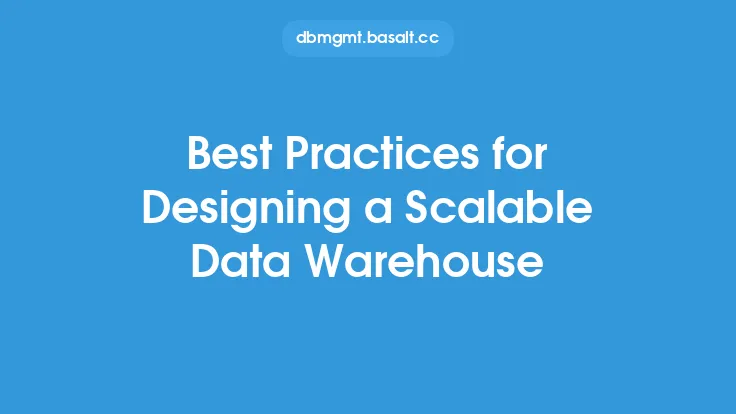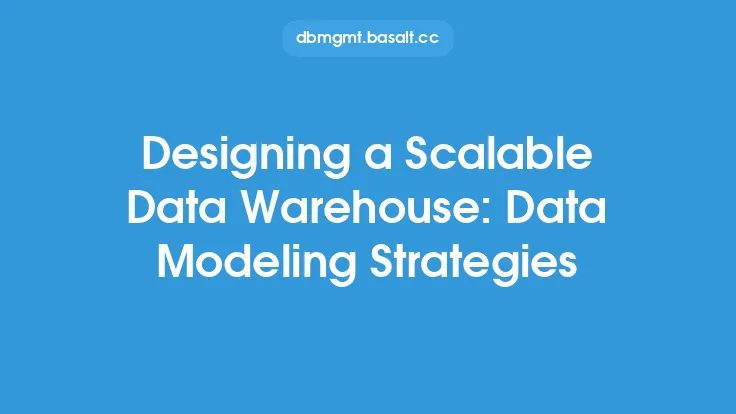Designing a scalable data warehouse is a critical aspect of long-term data management, as it enables organizations to store, manage, and analyze large volumes of data from various sources. A well-designed data warehouse provides a centralized repository for data, making it easier to access, analyze, and report on data to support business decision-making. In this article, we will delve into the key considerations and best practices for designing a scalable data warehouse.
Introduction to Data Warehouse Design
A data warehouse is a database designed to support business intelligence activities, such as data analysis, reporting, and data mining. It is typically used to store historical data, which can be used to analyze trends, identify patterns, and make predictions about future business outcomes. A scalable data warehouse design is essential to ensure that the system can handle increasing volumes of data and user queries without compromising performance.
Key Considerations for Scalable Data Warehouse Design
When designing a scalable data warehouse, several key considerations must be taken into account. These include:
- Data volume and growth rate: The data warehouse must be designed to handle the current and projected data volume, as well as the growth rate of the data.
- Data complexity: The data warehouse must be able to handle complex data structures, such as hierarchical and relational data.
- Query patterns and workload: The data warehouse must be designed to handle the types of queries and workloads that will be executed against it.
- Data freshness and latency: The data warehouse must be designed to provide timely and up-to-date data to support business decision-making.
- Security and access control: The data warehouse must be designed to ensure that sensitive data is protected and access is controlled.
Data Warehouse Architecture
A scalable data warehouse architecture typically consists of several layers, including:
- Source systems: These are the systems that generate the data that will be stored in the data warehouse.
- Data ingestion layer: This layer is responsible for extracting data from the source systems and loading it into the data warehouse.
- Data storage layer: This layer is responsible for storing the data in the data warehouse.
- Data processing layer: This layer is responsible for processing and transforming the data into a format that can be used for analysis.
- Data presentation layer: This layer is responsible for presenting the data to the users in a format that is easy to understand.
Data Modeling and Design
Data modeling and design are critical components of a scalable data warehouse. A well-designed data model provides a framework for organizing and structuring the data, making it easier to access and analyze. The data model should be designed to support the business requirements of the organization, and should include the following components:
- Fact tables: These tables contain the measurable data that will be used for analysis.
- Dimension tables: These tables contain the descriptive data that will be used to filter and aggregate the fact data.
- Star and snowflake schemas: These are design patterns that are used to optimize the data model for query performance.
Data Storage and Retrieval
Data storage and retrieval are critical components of a scalable data warehouse. The data storage solution should be designed to handle large volumes of data, and should provide fast and efficient data retrieval. Some common data storage solutions include:
- Relational databases: These databases use a fixed schema to store and manage data.
- Column-store databases: These databases store data in columns instead of rows, making them ideal for analytical workloads.
- NoSQL databases: These databases use a flexible schema to store and manage data, making them ideal for big data and real-time analytics.
Scalability and Performance
Scalability and performance are critical components of a scalable data warehouse. The data warehouse should be designed to handle increasing volumes of data and user queries without compromising performance. Some common techniques for improving scalability and performance include:
- Data partitioning: This involves dividing the data into smaller partitions to improve query performance.
- Indexing: This involves creating indexes on the data to improve query performance.
- Caching: This involves storing frequently accessed data in memory to improve query performance.
- Parallel processing: This involves using multiple processors to execute queries in parallel, improving query performance.
Data Governance and Security
Data governance and security are critical components of a scalable data warehouse. The data warehouse should be designed to ensure that sensitive data is protected and access is controlled. Some common techniques for improving data governance and security include:
- Access control: This involves controlling access to the data warehouse using authentication and authorization.
- Data encryption: This involves encrypting sensitive data to protect it from unauthorized access.
- Data masking: This involves masking sensitive data to protect it from unauthorized access.
- Auditing and logging: This involves tracking and logging all access to the data warehouse to detect and prevent security breaches.
Best Practices for Scalable Data Warehouse Design
Some best practices for designing a scalable data warehouse include:
- Start with a clear understanding of the business requirements: The data warehouse should be designed to support the business requirements of the organization.
- Use a scalable architecture: The data warehouse should be designed to handle increasing volumes of data and user queries without compromising performance.
- Use a flexible data model: The data model should be designed to support changing business requirements and data structures.
- Use data governance and security best practices: The data warehouse should be designed to ensure that sensitive data is protected and access is controlled.
- Monitor and optimize performance: The data warehouse should be monitored and optimized regularly to ensure that it is performing at optimal levels.





